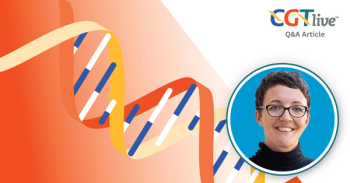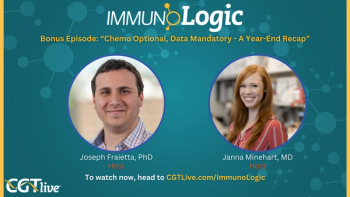
Wet AMD Gene Therapy Reduces Anti-VEGF Treatment Burden
Participants in the AAVIATE trial had up to an 85% decrease in treatment burden 6 months after treatment with RGX-314.
RGX-314, REGENXBIO’s investigational gene therapy for
These data were presented at the American Academy of Ophthalmology (AAO) annual meeting taking place September 30 – October 1 in Chicago, Illinois. Participants experienced no treatment-related serious adverse events (TEAEs) and REGENXBIO is adding a sixth cohort to the AAVIATE trial to evaluate a prophylactic ocular steroid regimen.
"Today's announcements come nearly a year into our collaboration with AbbVie to advance RGX-314 in wet AMD and other retinal diseases. These new subretinal and suprachoroidal data highlight the potential impact of RGX-314 for the millions of patients facing vision loss from wet AMD," Kenneth T. Mills, president and chief executive officer, REGENXBIO, said in a statement. "I am pleased with the continued progress on and momentum for these programs. We remain on track to submit a BLA for RGX-314 in 2024, and we expect to provide an update on the ALTITUDE trial of RGX-314 for the treatment of diabetic retinopathy using suprachoroidal delivery at the upcoming Retina Society Meeting in November."
Investigators have reported that as of August 1, 2022, suprachoroidal delivery of RGX-314 has been well-tolerated across 5 cohorts of participants with wet AMD enrolled in AAVIATE. No TEAEs have been reported although there were 15 serious AEs (SAEs) unrelated to treatment. Common TEAEs included conjunctival hemorrhage, increased intraocular pressure, episcleritis, and conjunctival hyperemia in 65 patients in cohorts 1 through 4 and these were mild or moderate. Participants treated at the first or second dose level had similar incidences of mild intraocular inflammation while those treated at the third dose level (cohort 4; 1x1012 GC/eye) had increased incidence of mild to moderate inflammation, all of which resolved with topical corticosteroids.
READ MORE:
The multicenter, open-label, randomized, dose-escalation AAVIATE trial is evaluating the safety and efficacy of suprachoroidal delivery of RGX-314. The trial is primarily evaluating mean change in vision at week 40 from baseline via Best Corrected Visual Acuity (BCVA) compared to patients receiving monthly injections of ranibizumab. The trial is also evaluating mean change in central retinal thickness (CRT) and the number of anti-vascular endothelial growth factor (anti-VEGF) intravitreal injections received after treatment with RGX-314.
Participants in the RGX-314 arm had a meaningful reduction in anti-VEGF treatment burden (range, -63.8% to –84.7%) compared to mean annualized injection rate during the 12 months prior to administration. Participants treated at the third dose level had the highest reduction in treatment burden, with a mean 1.3 injections over 6 months after RGX-314 treatment – an 84.7% reduction in anti-VEGDF treatment burden. Ten of these patients (67%) had no anti-VEGF injections in this time period while maintaining visual acuity and CRT. Data from the second dose level (cohorts 2 and 3) additionally suggest that there is no meaningful difference in safety and vision outcomes for patients who are neutralizing antibody (NAb) positive.
An additional cohort, cohort 6, will be enrolled at the third dose levelwith a short course of prophylactic ocular steroids to evaluate the effect on intraocular inflammation. Participants will be enrolled regardless of NAb status.
"We are pleased to share updated data from the AAVIATE trial, including new 6-month data from Cohorts 1-4 which provides continued evidence of the emerging clinical profile of RGX-314 for the treatment of wet AMD using suprachoroidal delivery," Steve Pakola, MD, chief medical officer, REGENXBIO, added to the statement. "RGX-314 continues to be well tolerated, with emerging evidence of treatment effect, including meaningful reduction in anti-VEGF treatment burden at all dose levels. We look forward to expanding this trial to further explore the third dose level."
REGENXBIO also presented data from a long-term follow-up (LTFU) study(NCT03999801) that evaluated subretinal delivery of RGX-314 in 37 patients with wet AMD. Investigators observed dose-dependent increases in treatment effect and 16 patients in cohorts 3 and 4 have continued to tolerate the treatment and have experienced a durable treatment effect for up to 4 years. Stable to improved visual acuity was observed, with a mean BCVA of +12 letters from baseline at four years for Cohort 3 patients and -5 letters from baseline at three years for Cohort 4 patients following RGX-314 administration.
Nine SAEs, none related to treatment, were reported. One participant, in cohort 5, had a significant decrease of vision during the LTFU study who had macular pigmentary changes after a superior bleb in the phase 1/2a trial.
The LTFU study also revealed a meaningful reduction in anti-VEGF treatment burden, with a decrease in mean annualized rate from 6.8 injections to 2.4 injection in cohort 3 (67% reduction) and from 10.2 injections to 4.4 injections in cohort 4 (58.4%). Altogether, these data are expected to support the anticipated biologic license application filing for RGX-314 in 2024.
"These positive interim data from the long-term follow-up and AAVIATE trials continue to reinforce the potential clinical benefit of a one-time administration of RGX-314 in the overall management of patients with neovascular AMD," Arshad M. Khanani, MD, MA, FASRS, director, clinical research, Sierra Eye Associates, Reno, Nevada, added to the statement. "I am extremely encouraged by this long-term data up to four years showing durable treatment effect and the potential of RGX-314 to meaningfully reduce injection burden for patients while maintaining vision outcomes. I look forward to the further investigation of RGX-314 in Cohort 6 of the AAVIATE trial, as in-office suprachoroidal delivery has the potential to be an important treatment option for patients."
The ATMOSPHERE (NCT04704921) and ASCENT (NCT05407636) pivotal trials are active and enrolling patients with wet AMD. REGENXBIO is also expecting to present new interim data on RGX-314 in diabetic retinopathy from ALTITUDE (NCT04567550) at the Retina Society 55th Annual Scientific Meeting in November 2022.
REFERENCE
REGENXBIO announces additional positive interim data from trials of RGX-314 for the treatment of wet AMD. News release. REGENXBIO. October 3, 2022. https://regenxbio.gcs-web.com/news-releases/news-release-details/regenxbio-announces-additional-positive-interim-data-trials-rgx
Newsletter
Stay at the forefront of cutting-edge science with CGT—your direct line to expert insights, breakthrough data, and real-time coverage of the latest advancements in cell and gene therapy.





































